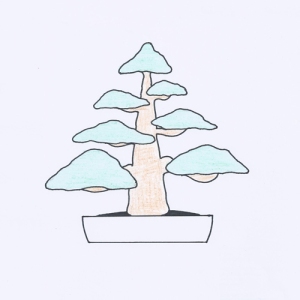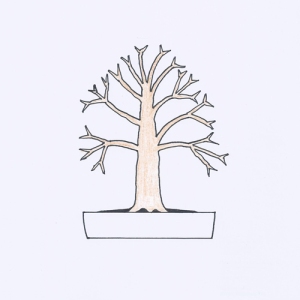Chokkan style Bonsai has straight, tapering, upright trunks with the branches being thickest and broadest at the bottom and thinnest and shortest at the top. Ideally there should be plenty of surface roots showing, radiating evenly from the trunk, slowly angling into the soil. If at all possible, there should not be any roots pointing directly at the viewer.
Chokkan style Bonsai are extremely popular. They mimic trees that are growing naturally in the wild, without other trees around them that will compete with them for light and nutrients. These trees will grow straight upright, aiming directly for the sun, with a very natural taper and stunning branch patterns. Often the branches are intact – very rarely will you see damaged branches on a tree such as this, unless caused by a violent natural disaster such as a lightning strike.
Creating your own Chokkan style Bonsai can be incredibly difficult. Firstly you will have to source a trunk that has the perfect taper, and then there’s the branch structure to grow out. Of course it is possible, but it will take many years before your Chokkan style Bonsai will begin to look as you intend it to look!
Finding suitable Chokkan style material in the wild will be near impossible as the trunks will invariably be very straight from the base – too straight to be of any use. So if you do intend on growing and creating your own true Chokkan style Bonsai, and you have plenty of time and patience, then the best approach will be to start from a number of cuttings and allow them to grow outside, under natural light, tending to them occasionally over a period of years until the trunk has grown sufficiently, then concentrate upon creating the appropriate branch structure.
Ideal species for Chokkan Bonsai
There are many species of shrubs and trees that are perfectly suited to Chokkan style Bonsai. Basically, if you have spotted a tree or shrub on your travels that is growing naturally with an upright stance and symmetrical pattern there’s a high chance that species will easily grow into a Chokkan Bonsai style. Some of the most popular species for this Bonsai style are:
- Junipers (Juniperus)
- Spruces (Picea
- Pines (Pinus)
- Maple (Acer)
Species that do not lend themselves to a formal Chokkan style are as follows, simply because they tend not to grow into a formal style naturally so you will continually battle against the tree’s natural growth:
- Pyracantha (Pyracantha)
- Crab Apple (Malus)
- Cherry (Prunus)
Click here for more in-depth information on the various styles of Bonsai.








